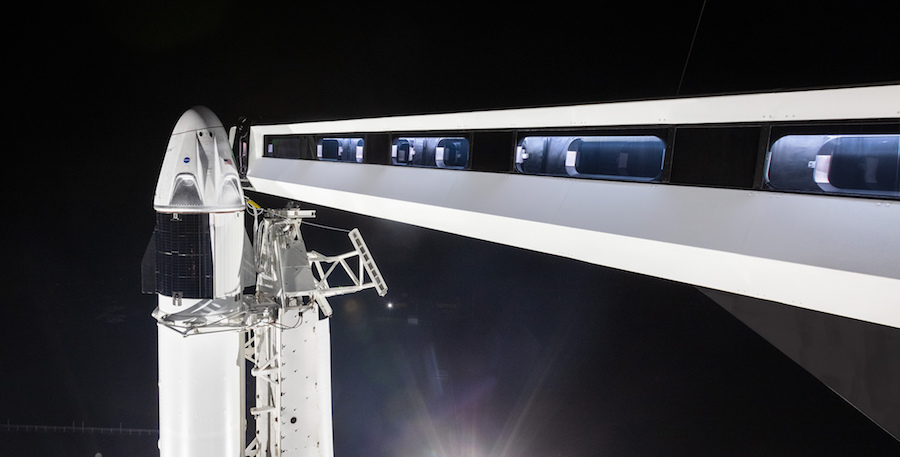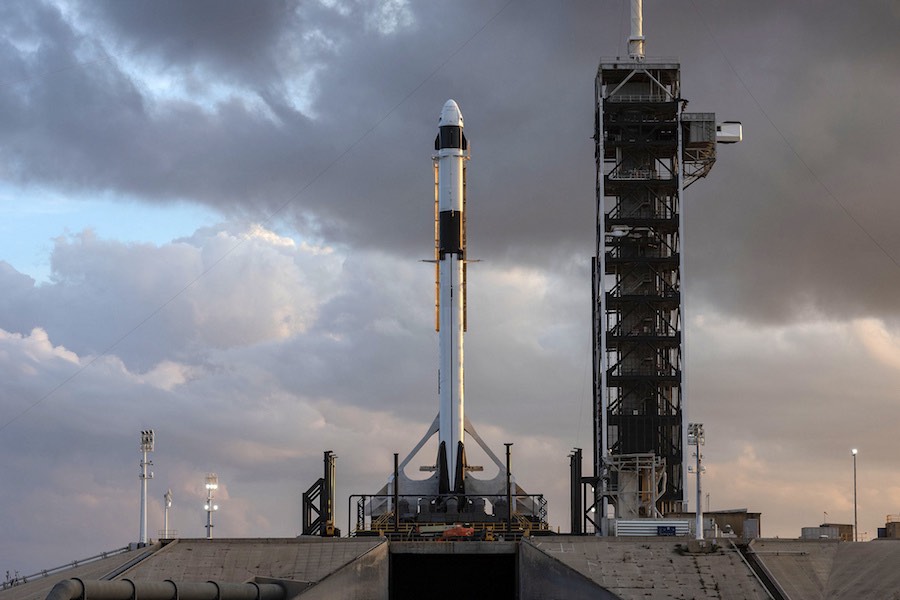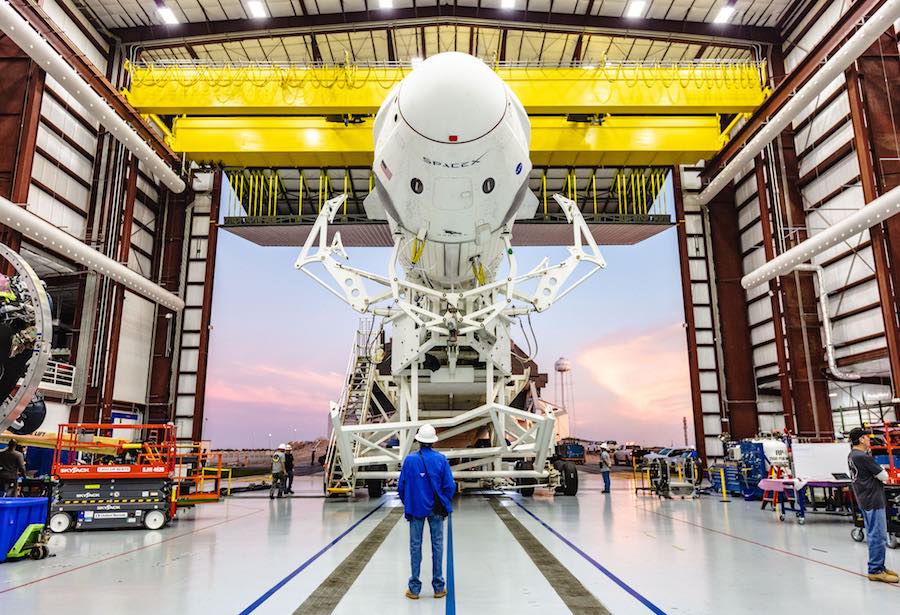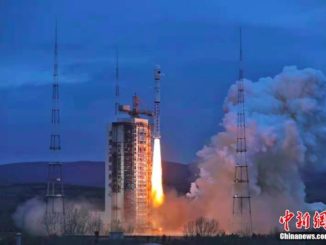EDITOR’S NOTE: Updated Jan. 10 with NASA statement confirming target launch date in February.

SpaceX founder Elon Musk said this weekend that the company is about one month away from launching the first Crew Dragon spacecraft on an unpiloted test flight to the International Space Station, a precursor to a demonstration launch with astronauts later this year. He also warned that early test flights of the commercial crew capsule, built under contract to NASA, will be “especially dangerous.”
Ground teams at NASA’s Kennedy Space Center in Florida rolled the Falcon 9 rocket and Crew Dragon spacecraft to pad 39A on Thursday, Jan. 3, then hydraulically lifted the launcher vertical for a series of fit checks at the seaside launch facility, which was once used to launch Saturn 5 moon rockets and space shuttles.
SpaceX lowered the Falcon 9 rocket Friday evening, but the booster was expected to soon return to its launch pedestal for further testing, including a countdown rehearsal and a fueling test to practice launch day procedures. A hold-down firing of the Falcon 9’s Merlin main engines is also on tap before the mission is ready to fly.
Officials have not set a new launch date for the Crew Dragon’s first test flight in low Earth orbit, a mission NASA and SpaceX call Demo-1. The test flight had been scheduled to lift off Jan. 17 from Florida’s Space Coast, but Musk tweeted Saturday that the Demo-1 mission’s launch is “about a month away.”
NASA issued a statement Thursday, Jan. 10, that said the Demo-1 launch is now expected some time in February.
NASA and SpaceX are continuing to work on the activities leading toward the Demo-1, uncrewed flight test to the International Space Station,” the agency said. “NASA and SpaceX are now targeting no earlier than February for the launch of Demo-1 to complete hardware testing and joint reviews. NASA and SpaceX will confirm a new target date after coordination with the Eastern Range and the International Space Station Program.”

In a tweet Sunday responding to a follower, Musk added that the mission will be “extremely intense.”
“Early flights are especially dangerous, as there’s a lot of new hardware,” Musk wrote.
The Crew Dragon spacecraft is a privately-developed, SpaceX-owned capsule NASA aims to use to ferry U.S. astronauts to and from the International Space Station, ending the space agency’s sole reliance on Russian Soyuz spacecraft for crew transportation to the orbiting research laboratory. NASA signed a $2.6 billion contract with SpaceX in 2014 to design, develop and fly the Crew Dragon spacecraft, and the agreement covers the two test flights — Demo-1 without astronauts and Demo-2 with astronauts on-board — and six operational crew rotation flights to the station once NASA reviews the results of the demonstration missions.
NASA has a similar $4.2 billion contract with Boeing for development of the CST-100 Starliner spacecraft, which will launch on United Launch Alliance Atlas 5 rockets, also from Cape Canaveral.
The Crew Dragon’s Demo-1 mission will launch aboard the Falcon 9 rocket into low Earth orbit, and rendezvous with the space station around 250 miles (400 kilometers) above Earth, moving in for an automated docking, a first-time achievement for SpaceX.
The company’s current Dragon cargo capsules are grappled by the station’s robotic arm. The Crew Dragon — also called Dragon 2 — represents a brand new spacecraft design, with new life support systems, crew accommodations, and propulsion, electrical and thermal control systems not used on the previous Dragon vehicles.
For example, the Crew Dragon features powerful hydrazine-fueled SuperDraco thruster pods that could be used to drive the capsule away from a failing launch vehicle. The spacecraft’s rear trunk section also has solar panels mounted on the outer mold line, and a thermal radiator to keep the craft’s temperature within limits. Crew-carrying Dragons will also have seats and an astronaut control panel.
The launch of Boeing’s first CST-100 test flight to low Earth orbit is expected later this year. It was most recently officially targeted for March, but that schedule is now out-of-date, and NASA has not provided a revised timeframe for the mission.

A funding lapse affecting many U.S. government agencies, including NASA, may force delays in the commercial crew test flights. NASA officials are responsible for numerous safety and certification reviews of the SpaceX and Boeing crew capsules before the test flights can go ahead, including evaluations of technical issues — such as parachute problems — faced by both companies.
While SpaceX can proceed with launch preparations at the Kennedy Space Center, some of the reviews require the participation of furloughed NASA employees, such as managers responsible for ensuring the spacecraft meets the agency’s requirements, and officials in charge of the space station program, the capsule’s destination.
After a few weeks in orbit, the Crew Dragon will undock from the space station and parachute to a splashdown at sea. If the flight goes well, NASA astronauts Doug Hurley and Bob Behnken could take their seats on the second Crew Dragon test flight to the space station as soon as this summer.
Email the author.
Follow Stephen Clark on Twitter: @StephenClark1.



